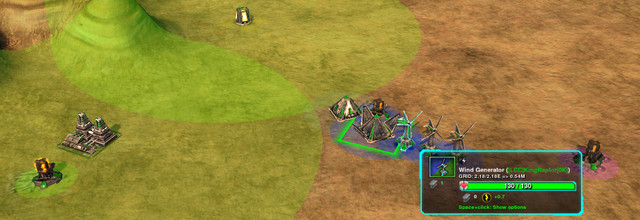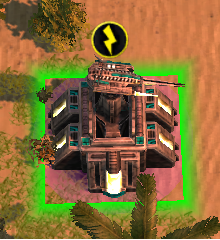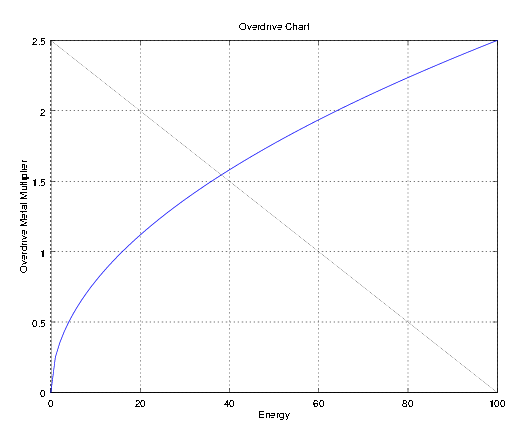Difference between revisions of "Overdrive"
m (→Efficiency tips: Remove stray line) |
GoogleFrog (talk | contribs) |
||
| Line 1: | Line 1: | ||
| − | '''Overdrive''' is | + | '''Overdrive''' is an ability of Metal Extractors that allows them to drain [[energy]] to multiply their [[metal]] income. It uses a grid mechanic that is also required by some powerful defense structures to function. |
| − | = | + | = Summary = |
| − | * Circles around metal extractors and energy sources | + | * Circles around metal extractors and energy sources show their grid influence. |
| − | * | + | * Structures are in the same grid if their circles overlap. |
| − | * | + | * The unused energy income in a grid is sent to the connected Metal Extractors to multiply their income. |
| − | * Grids can be connected | + | * Grids between allies can be connected. |
| − | * The more | + | * The more energy a Metal Extractor uses, the less efficient it will be. |
| − | * Some weapons ( | + | * Some weapons (Lucifer, Desolator, Cerberus) need a certain level of grid energy to function. |
| − | == | + | == Grid Expansion == |
| − | * If grid is pink or violet | + | * If a grid is pink or violet - Make sure you have some excess energy and connect Metal Extractors and energy structures together. |
| − | * If grid is light blue or green - | + | * If a grid is light blue or green - Keep adding energy. |
| − | * If grid is yellow or red - | + | * If a grid is yellow or red - The grid is inefficient. Spread out the energy by expanding the grid to connect more Metal Extractors. |
| − | + | = Explanation of Overdrive = | |
| − | + | The energy grid consists of your energy structures, [[Energy Pylon|pylon]]s, and [[Metal Extractor|mexes]]. Each Mex and energy structure has an effect field; two structures are linked if their effect fields overlap. Linking econ structures together creates a grid; the energy produced in the grid is the maximum energy that can be used to overdrive all the mexes in the grid. | |
| − | The energy | + | == Energy Distribution == |
| + | The energy available to overdrive is dependent on a teams energy storage, income and expenditure, according the following formula: | ||
| − | + | <code>Energy for Overdrive = (income - expenditure) * (storage / capacity)</code> | |
| − | The overdrive | + | A team with full energy storage spends all of its excess energy on overdrive. Overdrive always costs energy, and does not occur if a teams expenditure exceeds its income income. All the available energy is spent provided that there are sufficient grid connections. The total energy used by the metal extractors of a grid can never exceed the overdrive capacity of a grid. The total overdrive capacity of a grid is the summed energy income of each structure in that grid. |
| − | + | == Metal Generation == | |
| − | + | Overdrive generates metal by multiplying the income of mexes. Each mex spends energy individually, and receives income according to the following formula: | |
| − | + | <code>Overdrive Metal = (Base Income) * (sqrt(energy)/4)</code> | |
| − | + | For example, a mex with 2.2 base income and 4 overdrive energy generates 2.2*(sqrt(4)/4) = 1.1 overdrive metal. | |
| − | + | = Efficiency tips = | |
| + | Selecting an economy structure will show the effect fields of all econ structures. The color of the field denotes its efficiency: runs from purple to red as it becomes increasingly inefficient; pink means unlinked. If a structure is disabled for any reason (EMP, for instance), it loses its pylon functionality; the field turns grey to indicate this. | ||
| − | + | http://licho.eu/alba/Zero-K_Manual/pylongrid.sized.jpg | |
| − | + | == Diminishing Returns == | |
| + | The overdrive equation has diminishing returns. It takes 16 energy initially to double the income of a mex, and a further 64 energy (80 in total) to increase the output to triple its income. As a result, your metal to energy conversion ratio improves as more mexes are built and added to the grid. For example, 16 energy used on 4 equal mexes will overdrive each mex by 4 energy which is +50% income from each mex; +200% total. If instead you had 1 mex and 16 energy, all 16 energy would be used on that extractor for a +100% the metal income, twice as bad as 4 mexes. In practice only about half of your extractors need to be linked to an overdrive grid for most games. The cost and risk of linking extra extractors can be too great for the minimal gain of linking an already efficient grid. This efficiency is around 2x to 3x multiplier. | ||
| − | + | [[File:Zero-K_Overdrive_Chart.png]] | |
| − | |||
| − | |||
| − | |||
| − | |||
| − | |||
| − | |||
| − | + | == High Income Mexes == | |
| + | Some metal spots provide significantly more income than usual, so these spots are particularly good to overdrive. As overdrive acts as a multiplier to base income the high income mexes will want to be at a higher multiplier than other mexes even though increasing the multiplier costs more energy. You do not need to worry about reducing your metal income by linking, this can never happen. The overdrive equation has been solved mathematically to always produce the maximum metal income when faced with non-uniform extractor income. Try to capture metal spots with high incomes and overdrive them as much as possible. These extractors will max their grid sooner than others so make sure to keep track of their energy usage. | ||
| + | == Tooltips == | ||
The tooltips of Metal Extractors have information to display how efficient your overdrive is. For example: | The tooltips of Metal Extractors have information to display how efficient your overdrive is. For example: | ||
| Line 52: | Line 51: | ||
This shows the state of a single extractor. X is the base metal income of the extractor. Y% is the extra metal income from overdrive. Z is the energy used by this extractor to produce the extra Y% of income. | This shows the state of a single extractor. X is the base metal income of the extractor. Y% is the extra metal income from overdrive. Z is the energy used by this extractor to produce the extra Y% of income. | ||
Y and Z are always related by <code>Y = sqrt(Z)/4 x 100</code> | Y and Z are always related by <code>Y = sqrt(Z)/4 x 100</code> | ||
| − | |||
| − | |||
:'''E source - Extra Metal: X Energy Y / Z''' | :'''E source - Extra Metal: X Energy Y / Z''' | ||
| Line 59: | Line 56: | ||
This shows the behaviour of the energy grid that the structure is part of. X shows the total extra metal produced due to overdrive in this grid. Y shows the total energy expended to produce this metal. Z shows the energy production of all the energy structures of the grid, Z is the upper bound of Y. | This shows the behaviour of the energy grid that the structure is part of. X shows the total extra metal produced due to overdrive in this grid. Y shows the total energy expended to produce this metal. Z shows the energy production of all the energy structures of the grid, Z is the upper bound of Y. | ||
| − | == High-energy weapons == | + | === High-energy weapons === |
Some defense structures also require a connection to a grid in order to function (e.g. [[Cerberus]], [[Desolator]], [[Lucifer]]). The grid must have a minimum power output; however, any number of structures can use the same grid. | Some defense structures also require a connection to a grid in order to function (e.g. [[Cerberus]], [[Desolator]], [[Lucifer]]). The grid must have a minimum power output; however, any number of structures can use the same grid. | ||
Revision as of 05:33, 17 April 2019
Overdrive is an ability of Metal Extractors that allows them to drain energy to multiply their metal income. It uses a grid mechanic that is also required by some powerful defense structures to function.
Contents
Summary
- Circles around metal extractors and energy sources show their grid influence.
- Structures are in the same grid if their circles overlap.
- The unused energy income in a grid is sent to the connected Metal Extractors to multiply their income.
- Grids between allies can be connected.
- The more energy a Metal Extractor uses, the less efficient it will be.
- Some weapons (Lucifer, Desolator, Cerberus) need a certain level of grid energy to function.
Grid Expansion
- If a grid is pink or violet - Make sure you have some excess energy and connect Metal Extractors and energy structures together.
- If a grid is light blue or green - Keep adding energy.
- If a grid is yellow or red - The grid is inefficient. Spread out the energy by expanding the grid to connect more Metal Extractors.
Explanation of Overdrive
The energy grid consists of your energy structures, pylons, and mexes. Each Mex and energy structure has an effect field; two structures are linked if their effect fields overlap. Linking econ structures together creates a grid; the energy produced in the grid is the maximum energy that can be used to overdrive all the mexes in the grid.
Energy Distribution
The energy available to overdrive is dependent on a teams energy storage, income and expenditure, according the following formula:
Energy for Overdrive = (income - expenditure) * (storage / capacity)
A team with full energy storage spends all of its excess energy on overdrive. Overdrive always costs energy, and does not occur if a teams expenditure exceeds its income income. All the available energy is spent provided that there are sufficient grid connections. The total energy used by the metal extractors of a grid can never exceed the overdrive capacity of a grid. The total overdrive capacity of a grid is the summed energy income of each structure in that grid.
Metal Generation
Overdrive generates metal by multiplying the income of mexes. Each mex spends energy individually, and receives income according to the following formula:
Overdrive Metal = (Base Income) * (sqrt(energy)/4)
For example, a mex with 2.2 base income and 4 overdrive energy generates 2.2*(sqrt(4)/4) = 1.1 overdrive metal.
Efficiency tips
Selecting an economy structure will show the effect fields of all econ structures. The color of the field denotes its efficiency: runs from purple to red as it becomes increasingly inefficient; pink means unlinked. If a structure is disabled for any reason (EMP, for instance), it loses its pylon functionality; the field turns grey to indicate this.

Diminishing Returns
The overdrive equation has diminishing returns. It takes 16 energy initially to double the income of a mex, and a further 64 energy (80 in total) to increase the output to triple its income. As a result, your metal to energy conversion ratio improves as more mexes are built and added to the grid. For example, 16 energy used on 4 equal mexes will overdrive each mex by 4 energy which is +50% income from each mex; +200% total. If instead you had 1 mex and 16 energy, all 16 energy would be used on that extractor for a +100% the metal income, twice as bad as 4 mexes. In practice only about half of your extractors need to be linked to an overdrive grid for most games. The cost and risk of linking extra extractors can be too great for the minimal gain of linking an already efficient grid. This efficiency is around 2x to 3x multiplier.
High Income Mexes
Some metal spots provide significantly more income than usual, so these spots are particularly good to overdrive. As overdrive acts as a multiplier to base income the high income mexes will want to be at a higher multiplier than other mexes even though increasing the multiplier costs more energy. You do not need to worry about reducing your metal income by linking, this can never happen. The overdrive equation has been solved mathematically to always produce the maximum metal income when faced with non-uniform extractor income. Try to capture metal spots with high incomes and overdrive them as much as possible. These extractors will max their grid sooner than others so make sure to keep track of their energy usage.
Tooltips
The tooltips of Metal Extractors have information to display how efficient your overdrive is. For example:
- Metal Extractor - Makes:X + Overdrive: + Y% Energy:Z
This shows the state of a single extractor. X is the base metal income of the extractor. Y% is the extra metal income from overdrive. Z is the energy used by this extractor to produce the extra Y% of income.
Y and Z are always related by Y = sqrt(Z)/4 x 100
- E source - Extra Metal: X Energy Y / Z
This shows the behaviour of the energy grid that the structure is part of. X shows the total extra metal produced due to overdrive in this grid. Y shows the total energy expended to produce this metal. Z shows the energy production of all the energy structures of the grid, Z is the upper bound of Y.
High-energy weapons
Some defense structures also require a connection to a grid in order to function (e.g. Cerberus, Desolator, Lucifer). The grid must have a minimum power output; however, any number of structures can use the same grid.
If a defense structure is not connected to a sufficiently powerful grid, an energy icon will display over it.

